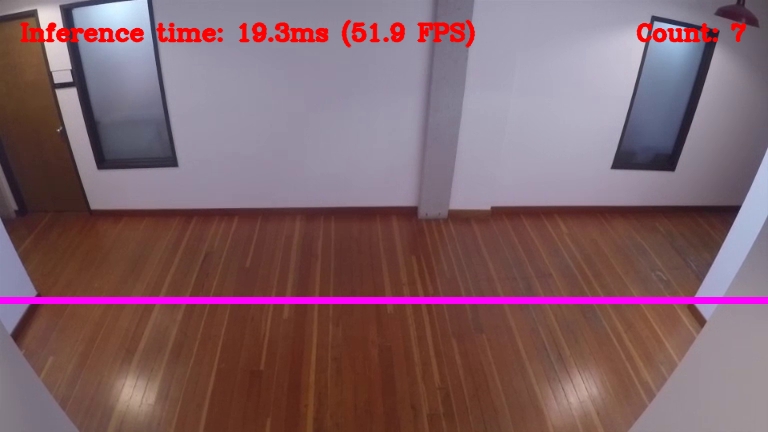Person Counting System using YOLOV8 and OpenVINO™#
This Jupyter notebook can be launched on-line, opening an interactive environment in a browser window. You can also make a local installation. Choose one of the following options:
In this project, we utilized YOLOV8 Object Counting class to develop a real-time people counting system using the YOLOv8 object detection model, optimized for Intel’s OpenVINO toolkit to enhance inferencing speed. This system effectively monitors the number of individuals entering and exiting a room, leveraging the optimized YOLOv8 model for accurate people detection under varied conditions.
By utilizing the OpenVINO runtime on Intel hardware, the system achieves significant improvements in processing speed, making it ideal for applications requiring real-time data, such as occupancy management and traffic flow control in public spaces and commercial settings.
NOTE: To use this notebook with a webcam, you need to run the notebook on a computer with a webcam. If you run the notebook on a server, the webcam will not work. However, you can still do inference on a video.
Table of contents:
Installation Instructions#
This is a self-contained example that relies solely on its own code.
We recommend running the notebook in a virtual environment. You only need a Jupyter server to start. For details, please refer to Installation Guide.
Install pre-requisites#
%pip uninstall -q -y "openvino-python-headless" "opencv-python"
%pip install -q "ultralytics==8.3.59" "torch>=2.1" --extra-index-url https://download.pytorch.org/whl/cpu
%pip install -q "openvino>=2024.0.0" "opencv-python" "lap>=0.4" "shapely"
Download Model#
Download and convert YOLOV8 to OpenVINO Intermediate Representation
from pathlib import Path
from ultralytics import YOLO
import requests
if not Path("notebook_utils.py").exists():
r = requests.get(
url="https://raw.githubusercontent.com/openvinotoolkit/openvino_notebooks/latest/utils/notebook_utils.py",
)
open("notebook_utils.py", "w").write(r.text)
# Read more about telemetry collection at https://github.com/openvinotoolkit/openvino_notebooks?tab=readme-ov-file#-telemetry
from notebook_utils import collect_telemetry
collect_telemetry("person-counting.ipynb")
models_dir = Path("./models")
models_dir.mkdir(exist_ok=True)
DET_MODEL_NAME = "yolov8n"
det_model = YOLO(models_dir / f"{DET_MODEL_NAME}.pt")
label_map = det_model.model.names
# Need to make en empty call to initialize the model
res = det_model()
det_model_path = models_dir / f"{DET_MODEL_NAME}_openvino_model/{DET_MODEL_NAME}.xml"
if not det_model_path.exists():
det_model.export(format="openvino", dynamic=True, half=True)
WARNING ⚠️ 'source' is missing. Using 'source=/home/ea/work/notebooks_env/lib/python3.8/site-packages/ultralytics/assets'.
image 1/2 /home/ea/work/notebooks_env/lib/python3.8/site-packages/ultralytics/assets/bus.jpg: 640x480 4 persons, 1 bus, 1 stop sign, 110.2ms
image 2/2 /home/ea/work/notebooks_env/lib/python3.8/site-packages/ultralytics/assets/zidane.jpg: 384x640 2 persons, 1 tie, 83.6ms
Speed: 2.4ms preprocess, 96.9ms inference, 248.0ms postprocess per image at shape (1, 3, 384, 640)
Inference function#
from ultralytics import YOLO
from ultralytics.solutions import ObjectCounter
import cv2
import time
import collections
import numpy as np
from IPython import display
import torch
import openvino as ov
def run_inference(source, device):
core = ov.Core()
det_ov_model = core.read_model(det_model_path)
ov_config = {}
if device.value != "CPU":
det_ov_model.reshape({0: [1, 3, 640, 640]})
if "GPU" in device.value or ("AUTO" in device.value and "GPU" in core.available_devices):
ov_config = {"GPU_DISABLE_WINOGRAD_CONVOLUTION": "YES"}
compiled_model = core.compile_model(det_ov_model, device.value, ov_config)
def infer(*args):
result = compiled_model(args)
return torch.from_numpy(result[0])
# Use openVINO as inference engine
det_model.predictor.inference = infer
det_model.predictor.model.pt = False
try:
cap = cv2.VideoCapture(source)
assert cap.isOpened(), "Error reading video file"
line_points = [(0, 300), (1080, 300)] # line or region points
# Init Object Counter
counter = ObjectCounter(show=False, region=line_points, model=det_model_path.parent, line_width=2, show_in=False, show_out=False)
compiled_model.track = counter.model.track
counter.model = compiled_model
# Processing time
processing_times = collections.deque(maxlen=200)
while cap.isOpened():
success, frame = cap.read()
if not success:
print("Video frame is empty or video processing has been successfully completed.")
break
start_time = time.time()
frame = counter.count(frame)
stop_time = time.time()
processing_times.append(stop_time - start_time)
# Mean processing time [ms].
_, f_width = frame.shape[:2]
processing_time = np.mean(processing_times) * 1000
fps = 1000 / processing_time
cv2.putText(
img=frame,
text=f"Inference time: {processing_time:.1f}ms ({fps:.1f} FPS)",
org=(20, 40),
fontFace=cv2.FONT_HERSHEY_COMPLEX,
fontScale=f_width / 1000,
color=(0, 0, 255),
thickness=2,
lineType=cv2.LINE_AA,
)
# Get the counts. Counts are getting as 'OUT'
# Modify this logic accordingly
counts = counter.out_count
# Define the text to display
text = f"Count: {counts}"
fontFace = cv2.FONT_HERSHEY_COMPLEX
fontScale = 0.75 # Adjust scale as needed
thickness = 2
# Calculate the size of the text box
(text_width, text_height), _ = cv2.getTextSize(text, fontFace, fontScale, thickness)
# Define the upper right corner for the text
top_right_corner = (frame.shape[1] - text_width - 20, 40)
# Draw the count of "OUT" on the frame
cv2.putText(
img=frame,
text=text,
org=(top_right_corner[0], top_right_corner[1]),
fontFace=fontFace,
fontScale=fontScale,
color=(0, 0, 255),
thickness=thickness,
lineType=cv2.LINE_AA,
)
# Show the frame
_, encoded_img = cv2.imencode(ext=".jpg", img=frame, params=[cv2.IMWRITE_JPEG_QUALITY, 100])
# Create an IPython image.
i = display.Image(data=encoded_img)
# Display the image in this notebook.
display.clear_output(wait=True)
display.display(i)
except KeyboardInterrupt:
print("Interrupted")
cap.release()
cv2.destroyAllWindows()
Run live demo#
from notebook_utils import download_file
WEBCAM_INFERENCE = False
if WEBCAM_INFERENCE:
VIDEO_SOURCE = 0 # Webcam
else:
VIDEO_SOURCE = Path("people-detection.mp4")
if not VIDEO_SOURCE.exists():
download_file("https://storage.openvinotoolkit.org/data/test_data/videos/people-detection.mp4")
**NOTE**: make sure to restart kernel and run all cells when
switching between video and webcam to avoid any errors.
Select inference device#
from notebook_utils import device_widget
device = device_widget()
device
Dropdown(description='Device:', index=3, options=('CPU', 'GPU.0', 'GPU.1', 'AUTO'), value='AUTO')
run_inference(
source=VIDEO_SOURCE,
device=device,
)

Video frame is empty or video processing has been successfully completed.